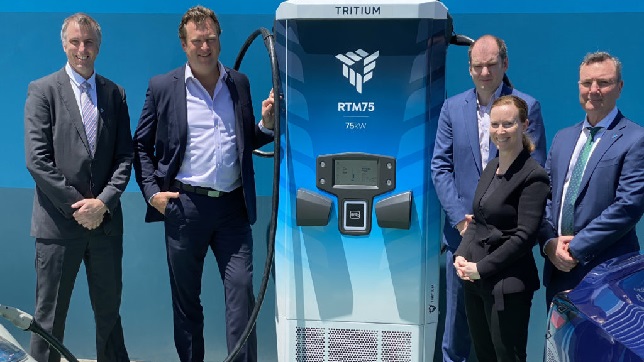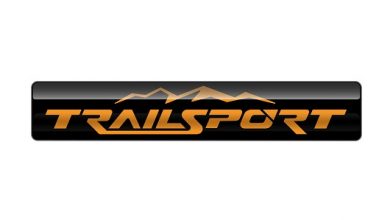Tritium unveils world first scalable electric vehicle charging platform
MSC hardware platform allows operators to incrementally scale charger deployments to meet the unique needs of specific environments for the first time

Tritium, a global leader in DC fast charging technology for electric vehicles (EVs), has unveiled the first platform to enable truly scalable electric vehicle charging networks anywhere in the world, with the launch of its MSC hardware platform.
The MSC (Modular Scalable Charging) hardware platform provides customers with the flexibility to increase the power level of their charger as EV charging capabilities advance, and “pay as you grow”. Charger power can be increased in 25kW increments, starting at 25kW and increasing to 350kW and beyond.
As part of the launch, the company also revealed the first charger built on the platform with the unveiling of its next-gen RTM75 DC Fast Charger, allowing drivers to add 75 km (46 mi) of range to an electric vehicle in 10 minutes of charging. The slim charger also allows for simultaneous charging of two vehicles at once and is built with urban, retail, fleet and public environments in mind.
“This has been something the industry and our customers have asked for over the years, and we are the first company in the world to deliver it,” said Jane Hunter, CEO of Tritium. “With our MSC platform, 50kW DC chargers can quickly be upgraded to 75kW, 100kW, and beyond, without a rip-and-replace required.”
“This solution is future-proofing governments and network operators across the globe, something they have been crying out for. No longer is a charger just a charger; instead, it’s a first step to meet the needs of both today’s and tomorrow’s electric vehicles.”
MSC Hardware Platform to Revolutionise EV Charger Networks with True Future-Proof Capability
Previously, network operators were required to pre-order and install chargers from a set of prefabricated charging options; often set at 50kW (fast or rapid chargers), 175kW or 350kW (high power or ultra-fast chargers).
However, the MSC hardware platform allows for the quick installation of additional power electronics modules within each MSC-designed charger, such as the RTM75 and future iterations of Tritium chargers. For instance, charger operators can purchase an RTM75 charger but start at 25kW or 50kW, pending their current power requirements, and scale to 75kW as their charging needs increase.
“The MSC hardware platform provides the next level of capital efficiency and scalability while still providing all the great attributes Tritium’s products have become known for: design, slimness, and low maintenance,” said Dr David Finn, Chief Growth Officer and Founder, Tritium. “The electrification of transportation is at tipping point, so our customers want to know how they can easily extend their charging site capacity over the coming years. They want no regrets and capital efficient scaling of their charging sites. Tritium’s MSC Hardware Platform allows our customers to scale their charging sites for half the price and configure their charging sites for a desired reliability.”
“The MSC platform will allow Tritium to rapidly deploy new product and our aim is to provide at least one new product every quarter to address the needs of customers servicing the home/workplace, public, fleet depot, segments. The first product on the MSC Hardware Platform is the RTM75, with the PKM150 and PKM350 following in 2021.”
The RTM75: Built for workplace, public and fleet depot charging applications.
Recent announcements across the globe point to EVs becoming dominant on our roads in the near future. In the US, President-Elect Joe Biden proposed in the lead-up to the election a US$400 billion public investment in the automobile industry to improve battery technology and change the federal vehicle fleet to electric cars and trucks, while also installing 500,000 electric vehicle charging stations across the country. In Europe, July 2020 was a record-breaking month for EV registrations – according to JATO, a provider of automotive data, volumes that month rose 131 per cent year-on-year to 230,700. And in Australia, the South Australian Government has recently pledged to transition its entire Government fleet to EVs by 2030.
To cater for an expected increase in the need for public charging infrastructure, Tritium has worked in collaboration with their customers to develop a scalable solution that can be installed quickly in retail, urban and public environments where the demand for easy-to-access charging infrastructure will be most pronounced.
“We listened to the industry, our customers and to governments across the globe, and the RTM75 is the result of those conversations,” said Hunter. “These chargers can be installed quickly, scale as required, and are suitable to be installed anywhere; from shopping centre carparks, to urban environments, and at service stations, the RTM75 is ready for primetime.”
The RTM75 facilitates simultaneous charging for two EVs at a time and supports all charging standards on the market, including CCS and CHAdeMO, and satisfies the needs of all batteries up to 920V.
Further, the RTM75 is equipped with Plug and Charge (ISO 15118) technology, eliminating credit card payments or RFID authentication at the charger. Instead customers can pay through the charging cable when it communicates to the car directly; a driver simply plugs in their EV, charges their car, and drives away knowing that payment was automatically and securely managed via a set of digital authentication certificates that contain pre-approved payment and configurations.
Further, the RTM75 is equipped with Plug and Charge (ISO 15118) technology, eliminating credit card payments or RFID authentication at the charger. Instead customers can pay through the charging cable when it communicates to the car directly; a driver simply plugs in their EV, charges their car, and drives away knowing that payment was automatically and securely managed via a set of digital authentication certificates that contain pre-approved payment and configurations.
The RTM75 is designed to accommodate the most stringent acoustic noise regulations with ‘Whisper Mode’, giving owners the flexibility to derate the charger’s power to meet municipal noise abatement requirements. Coupled with the sealed electronics enclosure and legendary small footprint for which Tritium is renowned, the RTM75 can be installed in spaces where other chargers just simply cannot fit. The fully sealed enclosure significantly reduces wear and tear, decreasing the need for maintenance, and prolonging the life of the charger. This next-gen IP65 fully-sealed fast charger can withstand the elements from -35°C to +50°C (-31°F to +122°F), while keeping electronics free from dust, water, salt, or other contaminants.





One Comment